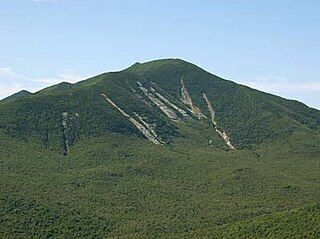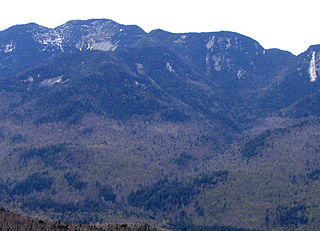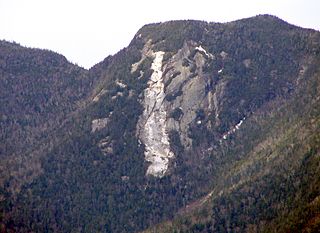Related Research Articles

The Adirondack Park is a park in northeastern New York protecting the Adirondack Mountains. The park was established in 1892 for "the free use of all the people for their health and pleasure", and for watershed protection. At 6.1 million acres, it is the largest park in the contiguous United States.

Mount Marcy is the highest point in the U.S. state of New York, with an elevation of 5,343.1 feet (1,628.6 m). It is located in the town of Keene in Essex County. The mountain is in the heart of the High Peaks Wilderness Area in Adirondack Park. Like the surrounding Adirondack Mountains, Marcy was heavily affected by large glaciers during recent ice ages, which deposited boulders on the mountain slopes and carved valleys and depressions on the mountain. One such depression is today filled by Lake Tear of the Clouds, which is often cited as the highest source of the Hudson River. The majority of the mountain is covered by hardwood and spruce-fir forests, although the highest few hundred feet are above the tree line. The peak is dominated by rocky outcrops, lichens, and alpine plants. The mountain supports a diverse number of woodland mammals and birds.

Algonquin Peak is a mountain in the MacIntyre Range of the Adirondacks in the U.S. state of New York. It is the second highest mountain in New York, with an elevation of 5,114 feet (1,559 m), and one of the 46 Adirondack High Peaks. It is located in the town of North Elba in Essex County and in the High Peaks Wilderness Area of Adirondack Park. The first recorded ascent of the mountain was made on August 8, 1837, by a party led by New York state geologist Ebenezer Emmons. It was originally named Mount McIntyre, after Archibald McIntyre, but this name was eventually applied to the entire range. Surveyor Verplanck Colvin added the name "Algonquin" in 1880. This name came from the peak reputedly being on the Algonquian side of a nearby informal boundary between the Algonquian and their Iroquois neighbors, although no such boundary existed in reality.

Dix Mountain is a mountain in the Dix Range of the Adirondacks in the U.S. state of New York. With an elevation of 4,857 feet (1,480 m), it is the sixth highest peak in New York and one of the 46 Adirondack High Peaks. It is located roughly on the boundary between the towns of North Hudson and Keene in Essex County, and in the High Peaks Wilderness Area of Adirondack Park. The crest of the peak consists of a very narrow ridge, which continues to the southeast and rises to a subsidiary peak named Beckhorn, then continues south to other peaks of the Dix Range. The summit is also in an alpine zone above the treeline. The ridge offers unobstructed views of Elk Lake to the southwest, the Great Range to the northwest, and Lake Champlain and the Green Mountains to the east.

Louis Marshall was an American corporate, constitutional and civil rights lawyer as well as a mediator and Jewish community leader who worked to secure religious, political, and cultural freedom for all minority groups. Among the founders of the American Jewish Committee (AJC), he defended Jewish and minority rights. He was also a conservationist, and the force behind re-establishing the New York State College of Forestry at Syracuse University, which evolved into today's State University of New York College of Environmental Science and Forestry (SUNY-ESF).

John Thomas Miner, OBE, or "Wild Goose Jack," was a Canadian conservationist called by some the "father" of North American conservationism.

William Edward Colby was an American lawyer, conservationist, and the first Secretary of the Sierra Club.

Tahawus was a village in the Town of Newcomb, Essex County, New York, United States. It is now a ghost town situated in the Adirondack Park. Tahawus is located in Essex County within the unpopulated northern area designated to the town of Newcomb. Tahawus was the site of major mining and iron smelting operations in the 19th century. Although standing as recently as 2005, the last mining facilities have since been demolished and removed.

Gray Peak is a mountain located in the town of Keene in Essex County, New York. It is the seventh-highest of the Adirondack High Peaks, with an elevation of 4,840 feet (1,480 m), and is located in close proximity to Mount Marcy, the highest peak in New York. Gray Peak is southwest of Mount Marcy and southeast of Mount Colden. The first recorded ascent of the peak was made on September 16, 1872, by surveyor Verplanck Colvin and guide Bill Nye. It was named for Asa Gray by Colvin. Although the mountain is only 0.6 miles (0.97 km) from the summit of Marcy and lacked prominence desired by the Marshall brothers for inclusion in the High Peaks, it was added to the list to preserve the name.

Gothics is a mountain in the Great Range of the Adirondacks in the U.S. state of New York. It is the tenth-highest peak in New York, with an elevation of 4,736 feet (1,444 m), and one of the 46 High Peaks in Adirondack Park. It is located in the town of Keene in Essex County. The mountain is named due to the resemblance of its three arched peaks and large rock slides to Gothic architecture. Although the name has been attributed to Orson Schofield Phelps and Frederick W. Perkins, who named several peaks during an 1857 ascent of Mount Marcy, other evidence shows the name Gothics in use at least as early as 1850. The earliest recorded ascent was made on October 11, 1875, by Verplanck Colvin, Roderick L. McKenzie, and Ed Phelps, although an unrecorded ascent was likely made earlier by James J. Storrow and Orlando Beede. The summit of Gothics is an alpine tundra zone, and on clear days views of 30 nearby peaks are available, as well as the Upper and Lower Ausable Lakes.

Basin Mountain is a mountain in the Great Range of the Adirondacks in the U.S. state of New York. It is the ninth-highest peak in New York, with an elevation of 4,827 feet (1,471 m), and one of the 46 High Peaks in Adirondack Park. It is located in the town of Keene in Essex County. The peak was named either for the basins formed between knobs on its slopes or the large basin to its southeast formed by it and the surrounding mountains. The name Basin was most likely coined by Orson Schofield Phelps and Frederick W. Perkins in 1857 during an ascent of Mount Marcy. The earliest appearance of the name in writing was made by surveyor Verplanck Colvin in 1873.
The Crater Club is a seasonal residential enclave on the shore of Lake Champlain approximately one mile south of Essex, New York within the Adirondack Park region. The club was originally developed as a summer retreat by the naturalist and outdoor writer John Bird Burnham in the early 1900s. Currently the Crater Club consists of over 40 homes, a clubhouse, playing fields, four clay tennis courts, and a waterfront featuring a permanent pier and a screened building known as Burnham's Landing. This latter building is also the headquarters of the Split Rock Yacht Club, which maintains a small but active racing fleet of Cape Cod Knockabout sailboats and holds weekly sailboat races during the summer season open to these and other small one-design classes.

Anne LaBastille was an American author, ecologist, and photographer. She was the author of more than a dozen books, including Woodswoman, Beyond Black Bear Lake, and Women of the Wilderness. She also wrote over 150 articles and over 25 scientific papers. She was honored by the World Wildlife Fund and the Explorers Club for her pioneering work in wildlife ecology in the United States and Guatemala. LaBastille also took many wildlife photographs, many of which were published in nature publications.
Grace Peak is a mountain located in Essex County, New York. It is part of the Dix Range, named after John A. Dix (1798–1879), New York Secretary of State in 1837, and later Governor. The mountain was formerly called East Dix, but in 2014 it was officially renamed Grace Peak in honor of Grace Hudowalski (1906–2004), who in 1937 became the ninth person and first woman to climb all 46 of the Adirondack High Peaks. Grace Peak is flanked to the northeast by Spotted Mountain, and to the southwest by South Dix.

Phelps Mountain is a mountain located in Essex County, New York. The mountain is named after Orson Schofield "Old Mountain" Phelps (1817–1905), who cut the first trail up Mount Marcy and named several of the Adirondack peaks. It is the 32nd highest peak in New York. Phelps Mountain is flanked to the southeast by Table Top Mountain.

Armstrong Mountain is a mountain located in Essex County, New York, named after Thomas Armstrong, a local pioneer. The mountain is part of the Great Range of the Adirondack Mountains. Armstrong Mtn. is flanked to the southwest by Gothics, and to the northeast by Upper Wolfjaw Mountain.

Lower Wolfjaw Mountain is located in Essex County, New York, United States. Landscape artist Alexander Helwig Wyant (1836–1892) named Lower Wolfjaw, together with neighboring Upper Wolfjaw Mountain, about 1870 for their appearance in profile. The mountain is the northeasternmost of the Adirondack High Peaks in the Great Range of the Adirondack Mountains. Lower Wolfjaw Mountain is flanked to the southwest by Upper Wolfjaw Mountain, and to the northeast by Hedgehog Mountain.

Upper Wolfjaw Mountain is a mountain located in Essex County, New York. Landscape artist Alexander Helwig Wyant (1836–1892) named the mountain, in combination with neighboring Lower Wolfjaw Mountain, c. 1870 for their appearance in profile. The mountain is part of the Great Range of the Adirondack Mountains. Upper Wolfjaw Mtn. is flanked to the southwest by Armstrong Mountain, and to the northeast by Lower Wolfjaw Mtn.
Mount Marshall is a mountain in the MacIntyre Range of the Adirondacks in the U.S. state of New York. With an elevation of 4,360 feet (1,330 m), it is the 25th highest mountain in the Adirondacks and one of the 46 High Peaks in Adirondack Park. It is located in the town of Newcomb in Essex County, flanked to the northeast by Cold Brook Pass and Iroquois Peak. Originally named for Governor DeWitt Clinton, and then for mountain guide Herbert Clark, it was renamed for wilderness activist Bob Marshall after his death. The summit can be accessed by hikers on an unmarked trail.
Poke-O-Moonshine Mountain, spelled Pokamoonshine on U.S. Geological Survey maps, and sometimes known as just Poke-O, is a minor peak of the Adirondack Mountains. The name is believed to be a corruption of the Algonquin words pohqui, meaning 'broken', and moosie, meaning 'smooth'. It is located in the town of Chesterfield, New York, United States, on New York state Forest Preserve land, part of the Taylor Pond Wild Forest complex within the Adirondack Park. Due to its location next to the pass through which most travelers from the north enter the range, it has been called the "gateway to the Adirondacks".
References
- ↑ BURNHAM, John Bird, in Who's Who ion America (1926 edition); p. 383
- ↑ DeSormo, Maitland, John Bird Burnham, Klondiker, Adirondacker and Eminent Conservationist, Adirondack Yesteryears, Saranac Lake, New York, 1977
- ↑ Davis, Geo, "John Bird Burnham: Conservationist and Adventurer"
- ↑ Hotaling, Mary, "John Bird Burnham's Crater Club"
- ↑ Davis, Geo, "Made in Essex, NY: Adirondack Mountain Creams"
- ↑ Davis, Geo, "John Bird Burnham: Conservationist and Adventurer"